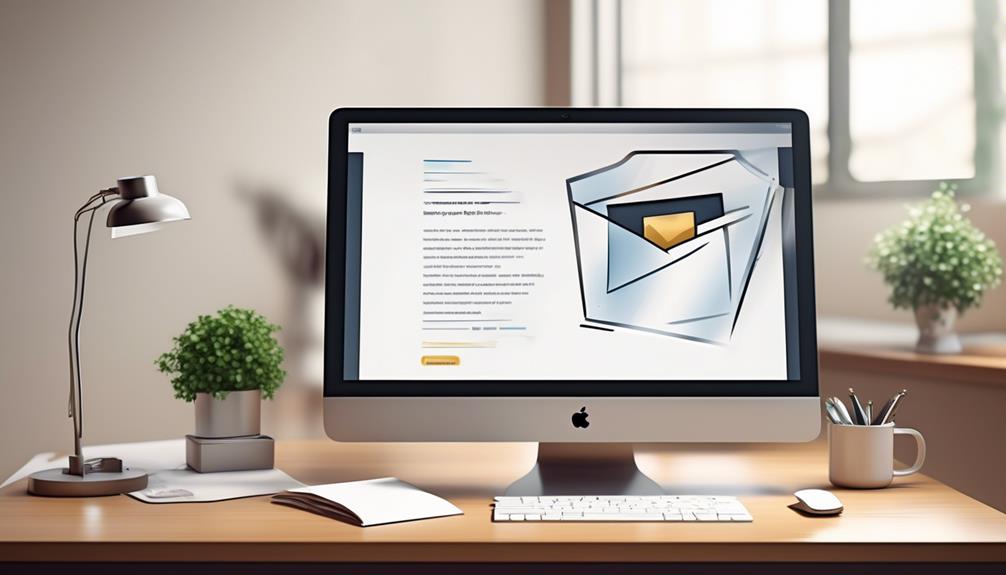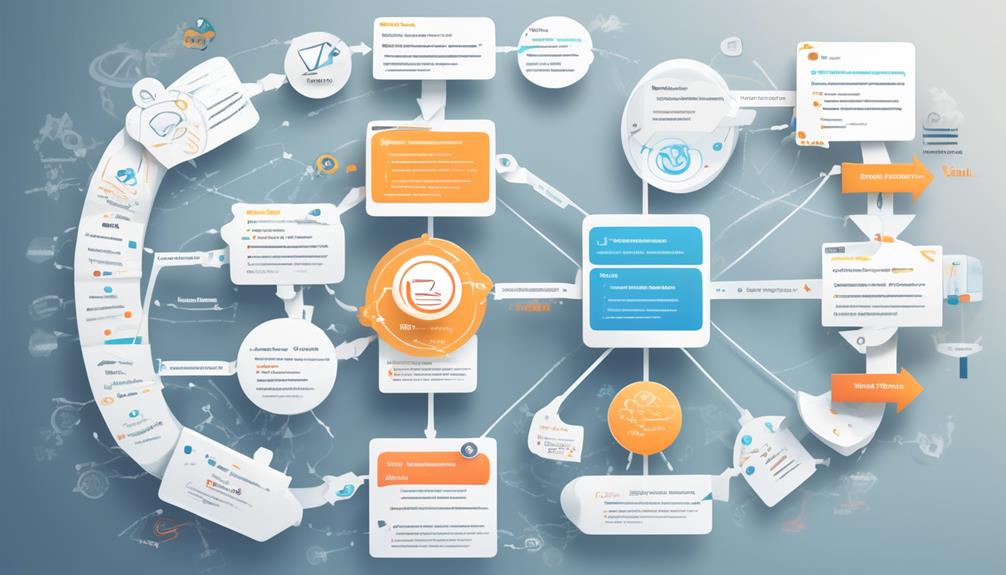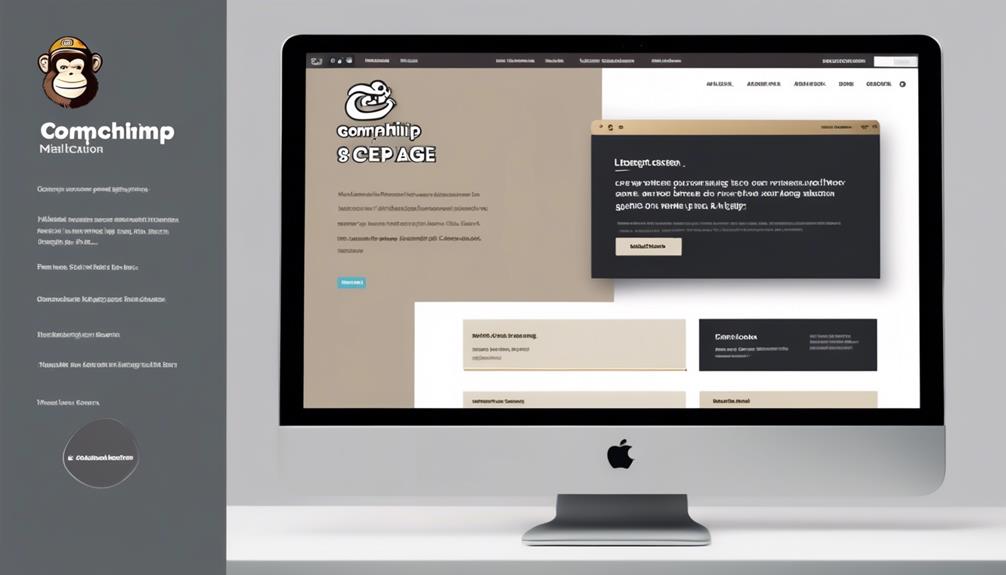As we begin to draft an email to a potential employer, it is important to keep in mind that our choice of words can open doors to new opportunities. Creating a message that maintains a professional yet genuine tone is vital in grabbing the interest of recruiters.
But how do we ensure our email stands out amidst the sea of applications flooding their inboxes? Let's explore the art of striking the right chord with a potential employer through a well-crafted email that could pave the way for future success.
Key Takeaways
- Craft a clear and personalized subject line that stands out.
- Research the recipient and the company to personalize your email effectively.
- Maintain a professional and enthusiastic tone that aligns with the company's values.
- Structure your email content to include a brief introduction, qualifications, and relevant experience.
Crafting the Perfect Subject Line
Crafting the perfect subject line for our email to a potential employer is a crucial step in capturing their attention and increasing the chances of a positive response. When emailing a hiring manager, it's essential to use a clear subject line that conveys the purpose of the email effectively.
Including the recipient's name and the company name in the subject line can personalize the email and show genuine interest in the position. To write a professional email, we should craft a subject line that's concise, specific, and relevant to the job application email. By using keywords related to the job or industry, we can make the subject line stand out and demonstrate our understanding of the role.
Experimenting with different subject lines can help us determine which ones yield the best response rates, ensuring that our emails are effective in grabbing the hiring manager's attention.
Researching Recipient and Role

After crafting the perfect subject line to capture the hiring manager's attention, our next crucial step is to personalize the email by mentioning specific details about the recipient or their company when researching the recipient and role.
When conducting research on the hiring manager or potential employer, it is essential to gather information that can help tailor your email effectively. Here is a helpful table to guide your research efforts:
| Research Area | What to Look For | Why It's Important |
|---|---|---|
| Hiring Manager | LinkedIn profile | Personalize your email with relevant details about the recipient. |
| Company Background | Recent news or updates | Show that you are informed and interested in the company. |
| Shared Connections | Mutual interests | Establish a connection beyond the job application. |
| Company Culture | Values and work environment | Align your values with those of the company for a better fit. |
Mastering Language and Tone
Navigating the intricacies of language and tone in professional email correspondence is crucial for making a favorable impression on potential employers. When writing an email to a potential employer, mastering language and tone is key to effectively communicating your interest and suitability for the role.
Here are four essential tips to help you master the language and tone in your emails:
- Maintain a professional and formal tone: Keep your language polished and respectful throughout the email to convey professionalism and seriousness about the opportunity.
- Be clear and concise: Avoid using unnecessary jargon or complex language that may confuse the recipient. Get straight to the point while still expressing your enthusiasm for the role.
- Adapt to the company culture: Tailor your language and tone to align with the company's values and culture. Researching the organization beforehand can help you strike the right chord in your email.
- Show enthusiasm without being pushy: Express genuine interest in the career opportunity without coming across as desperate. Strike a balance between enthusiasm and professionalism in your tone.
Mastering the language and tone in your email can significantly impact how potential employers perceive you during the recruitment process.
Structuring Your Email Content

When structuring the content of your email, focus on presenting your qualifications and relevant experience concisely and effectively. Keep in mind that the recipient may receive numerous emails daily, so it's essential to make yours stand out. It's a good idea to organize your email content into clear sections to ensure easy readability. Here is a table to guide you on structuring your email effectively:
| Section | Description |
|---|---|
| Introduction | Briefly introduce yourself |
| Qualifications | Highlight your skills |
| Experience | Showcase your expertise |
When you write a job application email, make sure to address the recipient by name for a personalized touch. Mention your years of experience and why you would be a good fit for the position. It's also a good idea to attach your resume for additional information and consider including a cover letter if required. Remember to proofread your email before sending to ensure professionalism and clarity.
Polishing and Sending Your Email
As we refine our email content to capture the attention of potential employers, it's crucial to focus on polishing and sending our message with professionalism and clarity.
Here are some essential steps to consider when polishing and sending your email:
- Be concise and clear: Ensure your email is to the point and easy to read to maintain the recipient's attention.
- Customize your email: Tailor your message to the specific job and company you're applying to, showcasing why you're a great fit for the position.
- Proofread multiple times: Check for any errors in grammar, spelling, or formatting before hitting send to maintain a professional image.
- Send a follow-up email if necessary: If you don't receive a response within a reasonable timeframe, it's appropriate to follow up politely to express your continued interest in the position.
Frequently Asked Questions
How Do You Start an Email to a Potential Employer?
We typically start an email to a potential employer by addressing them with a professional greeting.
It's essential to clearly state the purpose of the email and briefly introduce ourselves and our qualifications.
Expressing interest in both the company and the position helps demonstrate enthusiasm.
Keeping the email concise and error-free is crucial.
Following up if there's no response is a good practice.
How Do You Write an Email for a Job Opportunity?
When writing an email for a job opportunity, we aim to showcase our qualifications and enthusiasm. It's crucial to tailor each email to the company's needs, highlighting our skills and experience.
Using a professional tone and language is key to making a good impression. Proofreading for errors ensures our communication is polished.
Follow-up is important if there's no response. Requesting a meeting and providing contact details show proactive engagement.
How to Write an Email to a Potential Employer After Applying?
When reaching out to a potential employer after applying, we aim to reinforce our interest and qualifications. We need to be respectful and concise, highlighting our relevant experience and how it aligns with the job.
It's crucial to personalize the email, mentioning specific details about the company or position. Attach necessary documents like your resume and cover letter and follow up if you don't hear back within a reasonable timeframe.
Is It a Good Idea to Email a Potential Employer?
Yes, it's a good idea to email a potential employer. It shows initiative and interest in the position.
A well-crafted email can set you apart from other applicants. Personalize the message and highlight your qualifications succinctly.
Be sure to use a professional tone and proofread for errors. A thoughtful email can make a positive impression and potentially lead to opportunities.
Can the same format and structure be used when writing an email to reschedule an interview as when writing to a potential employer?
When writing a rescheduled interview email, the format and structure can differ from reaching out to a potential employer. In the case of rescheduling, it’s crucial to be concise, apologetic, and propose new time options. While with potential employers, the tone should be professional and detailed about qualifications and interest.
Conclusion
We believe that by following these steps and guidelines, we can effectively communicate our request for a flexible work arrangement to our potential employer.
By showcasing our reasons for the request, previous success with flexible work, and willingness to find solutions, we hope to create a compelling case for consideration.
Thank you for taking the time to review our request and we look forward to discussing further.










